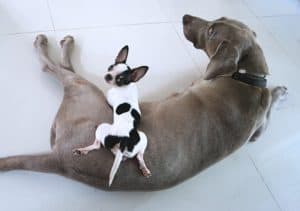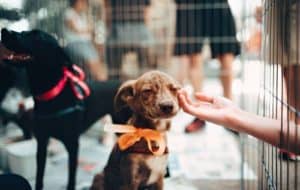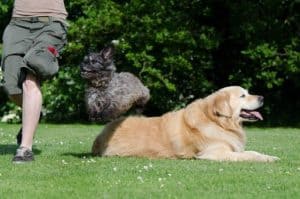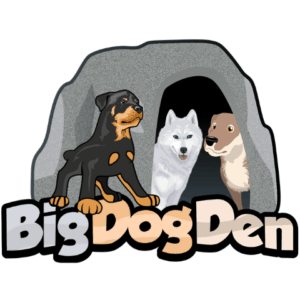Welcome to the Big Dog Den… I’m glad you’re here! I’m also glad that you’re doing your research. It shows that you are a responsible pet owner and that will reflect in your big dog’s behavior and temperament! Please allow me to jump right in with the answer to today’s title.
Can Big Dogs Play With Small Dogs?
Yes, big dogs can absolutely play with small dogs when you apply the 5 safety tips you’ll learn in this article. Renowned dog expert Cesar Millan says “Playing is a healthy part of socialization for dogs and it is definitely something to be encouraged.” Today’s tips don’t just apply to big dogs playing with small dogs, but also apply to big dogs playing with (or interacting with) any other animal(s).
In addition to covering the 5 safety tips for dogs playing together, I will also answer the most frequently asked questions (FAQ) I receive on this subject. We’ve got a lot of information to chew on, so let’s get started. Game on!
Tip One: Teach Your Big Dog The 5 Basic Commands FIRST
Training your big dog should begin the day after bringing him (or her) home. Ideally, this will be when he is still a puppy. A “clean slate” if you will. However, if your new dog is older, take heart! he (or she) can still be taught what behavior you expect from him (or her). The reason your dog should master the 5 basic commands before having play dates with other dogs (or any animals) is quite simple. It’s safety. The 5 Basic Commands are:
- Come!
- Heel!
- Sit!
- Down!
- Stay!
Do you see where each of these would be helpful in any situation? In scenarios where dogs are playing, their excitement can get the better of them, causing your dog to not listen as attentively to you as they normally would. For this reason and many more, those 5 commands will always be your greatest tools to utilize.
FAQ: Can big dogs and small dogs live together?
There is no reason why two (or more) healthy and well-trained dogs cannot live together. It is a rare occasion when this isn’t possible, although from time to time, I have heard of it.
Like humans, there exists a possibility for a dog not to get along with another dog (or any animal) for seemingly no reason. Perhaps animal relationships require a certain chemistry, just like we two-legged beings. Adhere to the tips you’ll receive in this article to ensure peaceful canine interactions in your home.

Tip Two: Socialize Your Big Dog Early
Socializing your big dog simply means you’ll be exposing him (or her) to as many people, dogs, and other animals and situations as possible. This is something you’ll want to do as early as possible in the dog’s life, and when he (or she) has adjusted to being walked on a leash. Keep reading to find out the best way to do this, and the safety points (and equipment) you should employ.
A dog who has not been properly socialized will grow to see unfamiliar humans and animals as a threat, and possibly act aggressively toward them.
Keep socializing a pleasant experience by keeping your mood light and easy and by rewarding your big dog with praise and/or treats for any good behaviors exhibited during the social encounters. If your dog reacts in a negative way, do not punish him (or her). Simply remove the dog from the environment and try again on a different day.
Most dogs enjoy new experiences, as well as other dogs. It won’t take your dog long to learn that good behavior is rewarded with a pleasurable experience, and soon he will look forward to social encounters with glee! Don’t forget to keep the safety of your big dog and any animals or humans nearby the priority!
FAQ: Can my puppy play with bigger dogs?
When it comes to young pups of any size playing with bigger dogs, the risk for injury (to the puppy) is higher. This is because puppies haven’t learned proper social etiquette yet, and a dog that isn’t the pup’s mother may not be as loving in making proper corrections in the pup’s behavior.
Pups yap, jump and nip as they play, and a big dog not familiar with puppies might not find the game amusing at all. Now don’t get me wrong, I am not saying a big dog cannot play perfectly fine with a puppy. I’m only pointing out that the risk for injury is higher.
For this reason, do not leave a bigger dog and a young puppy together unattended until enough time has passed with them together that you are sure the risk factor is gone. If you’re bringing a new puppy a home in which a bigger dog already lives, separate the two if you have to be away for an extended time (like a workday). I would recommend about four weeks of an “adjustment period” before you leave the two dogs together unattended.
Tip Three: Make Introductions Slowly with your Big Dog
Proper socializing for dogs should begin as early in your dog’s life as possible and be increased gradually. There are two pieces of safety equipment that should be employed upon initial introductions. These are a leash and a muzzle. Yes, a muzzle. We don’t muzzle our big dog because he’s mean. Rather, we muzzle our big dog at certain times because he is a dog, and dogs can (and WILL) bite in certain circumstances.
This is Maximus and new puppy being introduced and allowed to interact.

Steps to follow when introducing your big dog to another dog:
- Have your dog muzzled and on a leash at your side. If the idea of a muzzle seems archaic or cruel to you, please read “Muzzles: What you MUST Know” here in the Big Dog Den. It will put your mind at ease, I promise! I wrote it with my Rottweiler in mind, but the information certainly applies to all big dogs.
- Approach the other dog slowly or wait patiently as another dog approaches yours.
- Speak to both dogs in a calm and reassuring voice. Stroke your dog’s back if he takes an apprehensive stance. Like us, dogs can feel nervous upon making new acquaintances. If your dog exhibits any signs of aggression at this point, remove him (or her) immediately and try again at a different time. Some signs of aggression that may lead to biting are raised hackles, a low and steady growl, whale eyes, and excessive licking of the lips.
- If no signs of aggression have been displayed, while your dog is still on his leash, let him (or her) and the other dog sniff each other generously. Dogs are most driven by scent when interacting with other animals. Continue speaking in a gentle tone and observe both animals for any tell-tell signs of aggression (listed above).
- Once the animals exhibit a relaxed body posture reward them with rewards of praise and/or treats. Now that they are comfortable around each other if you’re in an area where it’s safe to do so (like a dog park or doggie daycare) go ahead and let them play for a spell, but keep a close eye on both to make sure the play is friendly and not escalating toward a very bad situation.
FAQ: Can a big dog kill a small dog?
A big dog can kill a small dog with a quickness! A large breed dog has about 300 pounds of pressure per square packed in his strong jaws! Even without intending, he (or she) could do serious bodily harm to a small dog up to and including killing him. This is one place a muzzle (of many) where a muzzle can save a life!
Big dogs are not naturally more aggressive than small dogs. In fact, the opposite is closer to the truth. But here’s the thing. If a smaller dog does act aggressively toward your big dog and your big dog decides to retaliate (because he’s a dog) he will certainly deliver more damage with his strong jaws than the smaller dog!
To learn more about big dogs and aggression, you may want to read an article I wrote a couple of months ago that is jam-packed with good information. You’ll find the article “Are Big Dogs Really More Aggressive?” right here in the Big Dog Den.
Tip Four: Know When to Use a Leash (and when not to)
So, we’ve already learned that for safety, a leash (and a muzzle) should be used when making introductions between your dog and another dog (or human). But when (and where) is it safe to remove the leash?
The leash can come off your dog in areas where it’s safe for dogs to run and play together. This can be anywhere designated for dogs, like the dog park or doggie daycare, or in a safe area like a fenced-in yard, or hiking trail where dogs are permitted to run free. When a dog is playing, his leash that’s used for his safety can become a risk for a choking or hanging injury.
In fact, unless your dog has a “breakaway collar“, you’ll want to remove his collar when he (or she) is playing with other dogs. One dog can get caught up by their teeth on the other dog’s collar and either dog is suddenly at risk for serious injury! When this happens, the collar can be pulled or twisted so tightly, you may not be able to remove it!
FAQ: Are big dogs good with small dogs?
We know now that not only can a big dog play with a smaller dog, but they can also even live together. I think you’d be surprised to witness how kind and gentle a big dog is toward a smaller dog he (or she) has become fond of! I own a Rottweiler than tops my weight named Maximus who visits his doggie daycare three times a week. While there, Max has interactions with dogs of all sizes.
With the bigger dogs, Max plays like a big dog. However, with the smaller dogs, the daycare proprietor reports, Max is gentle and kind. I’m told he even gets down on “their level” so the two can play together, with the smaller dog taking the lead. Check out the photo just below! Aren’t they cute together?!?

Of course, I (and the doggie daycare proprietor) followed all the safety runs mentioned here today in making introductions and monitoring the dog-play. I’ve heard owners of big dogs say their dog doesn’t know how big he (or she) is, but there is evidence to the contrary! Learn more by reading “Do Big Dogs Know How Big They Are?” right here in the Big Dog Den.
Tip Five: Supervise Your Big Dog at Play

I am not trying to be redundant in bringing up supervision again today. It’s just that important! So many dog tragedies, upon reflection, could have been avoided by adequate supervision! All dog-play should be supervised at all times, but especially when your dog is playing with a new acquaintance, a smaller animal, or a younger child.
No child should ever “rough-house” with your big dog or “ride him” (which causes injury to your dog’s hips), and any child who will be interacting with your dog should be trained to know the 5 basic commands, and which behaviors are acceptable and which are not when playing with dogs.
No dog ever attacks without provocation or warning, but it’s hard to determine what could provocate him (or her) to attack, even during play. We know a dog will attack if he feels threatened or feels as if his humans are being threatened. He (or she) might also attack if he is injured, or even if he is just startled.
Hands down, the best way to avoid a tragedy is to keep a close eye on the situation your big dog is involved in.
FAQ: Do big dogs get along with cats and other small animals?
I can tell you without hesitation or reservation that my Maximus get along splendidly with my small cat, Oreo. Need evidence? Look at this:
Oreo rubbing on Maximus by the pool.

I simply followed the exact procedures outlined here today, and before I knew it, Max and Oreo were the best of friends! The cat stalks and jumps on the dog at random, and I can’t even describe how funny it is to watch big ole Max try to mimic the cat, LOL!
I have friends who own a big dog and also a small animal, and they tell me the funniest stories! One friend has ferrets, another a bird, and I even have a friend with a pet bird and a big dog. I have only heard of one instance where a big dog and a smaller animal did not get along at all. Like I mentioned earlier, there are just some animals and/or people your big dog may not like for whatever reason.
A Word About Your Dog’s Temperament & Other Animals
A dog’s temperament is the sum of these four factors:
- Ancestry: The traits in your dog that are inherent.
- Environment: Your home can be peaceful or chaotic. Expect your dog to reflect that in his (or her) behavior.
- Health: Proper nutrition and hydration, exercise, and veterinary care.
- Training: Training may be done professionally or you can DIY. Either way, training begins on the day after your big dog arrives at your home and will be on-going and life-long.
Don’t think any dog breed is doomed to having a bad temperament because the breed is notorious for being skittish, or snappy, or even “mean”. No dog breed is any of these things just because of their ancestry. For a dog to have an all-around bad temperament means some of the other factors are amiss, too.
Take extra caution with a rescue dog for this reason. You most often won’t know a dog’s history when you rescue him (or her). If the dog was abused, malnourished, or neglected, you’ll have to spend extra time with him (or her) on factors 2-4 (above). Especially take care when it comes to socialization training. Most rescues will turn into the gentle giant you’re anticipating with some time, affection, and training. It is a rare occasion when the dog is beyond hope for becoming a well-rounded and healthy companion.

DID YOU KNOW?
Dogs are social in nature and susceptible to experiencing loneliness and boredom. This is why my Maximus goes to doggie daycare a few times a week, and we get to the dog park as often as we can. My husband and I both work full-time hours, and the cat only provides so much entertainment in a house that’s empty ten hours a day. Socialization is every bit as important to dogs as it is to humans. Get your dog out and have some fun together! The bonus is that doing things together enhances the bond between you and your four-legged best friend.

I hope that today’s article answered the questions you had about training your big dog to get along well with other animals of any size! When your dog is well-rounded and socialized, he (or she) is a pleasure for humans… and other animals… to be around!
Thanks for stopping by, see you around the Big Dog Den soon 🙂
*This article has been reviewed in accordance with our editorial policy.
